Book contents
- Frontmatter
- Contents
- Contributors
- Preface
- Common nomenclature
- 1 Introduction
- 2 Initiation of spouting
- 3 Empirical and analytical hydrodynamics
- 4 Computational fluid dynamic modeling of spouted beds
- 5 Conical spouted beds
- 6 Hydrodynamics of spout-fluid beds
- 7 Spouted and spout-fluid beds with draft tubes
- 8 Particle mixing and segregation
- 9 Heat and mass transfer
- 10 Powder–particle spouted beds
- 11 Drying of particulate solids
- 12 Drying of solutions, slurries, and pastes
- 13 Granulation and particle coating
- 14 The Wurster coater
- 15 Gasification, pyrolysis, and combustion
- 16 Spouted bed electrochemical reactors
- 17 Scaleup, slot-rectangular, and multiple spouting
- 18 Mechanical spouting
- 19 Catalytic reactors and their modeling
- 20 Liquid and liquid–gas spouting of solids
- Index
- References
4 - Computational fluid dynamic modeling of spouted beds
Published online by Cambridge University Press: 04 February 2011
- Frontmatter
- Contents
- Contributors
- Preface
- Common nomenclature
- 1 Introduction
- 2 Initiation of spouting
- 3 Empirical and analytical hydrodynamics
- 4 Computational fluid dynamic modeling of spouted beds
- 5 Conical spouted beds
- 6 Hydrodynamics of spout-fluid beds
- 7 Spouted and spout-fluid beds with draft tubes
- 8 Particle mixing and segregation
- 9 Heat and mass transfer
- 10 Powder–particle spouted beds
- 11 Drying of particulate solids
- 12 Drying of solutions, slurries, and pastes
- 13 Granulation and particle coating
- 14 The Wurster coater
- 15 Gasification, pyrolysis, and combustion
- 16 Spouted bed electrochemical reactors
- 17 Scaleup, slot-rectangular, and multiple spouting
- 18 Mechanical spouting
- 19 Catalytic reactors and their modeling
- 20 Liquid and liquid–gas spouting of solids
- Index
- References
Summary
Introduction
As reviewed in Chapter 3, numerous theoretical and experimental studies have been carried out in recent decades in an attempt to model the hydrodynamics of spouted beds. Most of the early models are one-dimensional, with spout and annulus considered separately by assuming that some parameters are constant. In addition, these models, though useful as first approximations, are complex, or require parameters to be determined by experiments.
Thanks to the explosion of computational power, the advance of numerical algorithms, and deeper understanding of multiphase flow phenomena, computational fluid dynamics (CFD) modeling has become a powerful tool for understanding dense gas–solid two-phase flows in the recent past. The main advantage of CFD modeling is that a wide range of flow properties of the gas and solids may be predicted simultaneously without disturbing the flows.
Currently, there are two main CFD approaches: the Eulerian-Eulerian approach (two-fluid model, TFM), and the Eulerian-Lagrangian (discrete element method, DEM) approach. In the following two sections, the fundamentals and applications of these two approaches in hydrodynamic modeling of spouted beds are treated separately. In each section, the main aspects of the CFD approach are introduced briefly, followed by application to modeling of spouted bed hydrodynamics. Comparison of the CFD predictions with experimental results is also discussed.
- Type
- Chapter
- Information
- Spouted and Spout-Fluid BedsFundamentals and Applications, pp. 57 - 81Publisher: Cambridge University PressPrint publication year: 2010



